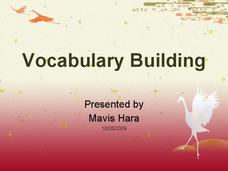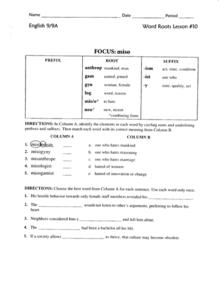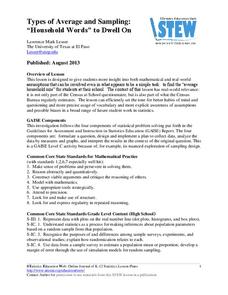EngageNY
Building Background Knowledge About the Hero’s Journey, Part 2: Acts 2 and 3 Plus Focusing on Key Vocabulary in “The Hero’s Journey”
It's all in the details. Scholars read acts two and three of The Hero's Journey and collect important details from the text. They share their notes with their peers and listen for key words from the story. They then turn their attention...
Curated OER
Vocabulary Building
Offer learners a step-by-step process for approaching unknown words with this PowerPoint presentation of vocabulary strategies, which details how to use context clues and word parts (roots, prefixes, suffixes), as well as encourages...
Curated OER
Word Meaning Activity
For this word meaning worksheet, students choose the word that describes a picture, 5 total. Worksheet is a basic vocabulary and word recognition activity.
Curated OER
Revising Writing: Plain English
Eschew obfuscation! Using dictionaries, writers revise a complicated text so that it reads more simply and improves the clarity of the passage. Focusing on word meanings, they revise the sample worksheets and then present their...
Curated OER
Word Roots Lesson #1 - Focus: chrom
What does the root word chrom mean? Review the root and the different prefixes and suffixes that can be added to it to enhance its meaning. Then, get your class using the new words with two short exercises. A brief introduction to the...
Curated OER
High Frequency Words
Phonemic awareness might not be a skill all autistic children will understand, but pattern and sight word recognition may prove to be more effective means of building strong reading skills. Use this set of twelve high frequency word...
Curated OER
Word Roots Lesson #4 - Focus: bio, opt/ops
Learners use knowledge of affixes and roots (bio, gen, metr, opt, ops, and phon) to determine the meaning of words. Then they use the words correctly in a several exercises. Part of a series of lesson using root words.
Curated OER
Word Roots Lesson #5 - Focus: therm
The roots chrono, gen, geo, graph, meter, and therm are featured on a worksheet that asks learners to identify the roots and affixes in a series of words, and then match the word with its meaning. Part of a series of exercises designed...
Curated OER
Word Roots Lesson #10 - Focus: miso
What does miso mean? Teach your class all about this root word with this quick practice sheet. After studying the chart provided, pupils learn new words that use the root and complete two short activities.
Curated OER
TAKS Quiz-Word Meaning
In this TAKS quiz learning exercise, students take an online quiz focused on word meaning similar to an underlined word. Quiz may be graded online by clicking a link.
Curated OER
Word Meanings From Context--Synonyms
In this synonyms worksheet, students look at each of the five words printed in italics before each selection and use context clues to identify and underline the synonym of each word.
Florida Center for Reading Research
Vocabulary: Morphemic Elements, Getting to the Root of It
Young readers learn how to get at the root of new vocabulary with this fun language arts activity. When working in pairs, children begin by matching unknown vocabulary words to their Greek or Latin roots. When all the vocabulary cards...
Florida Center for Reading Research
Vocabulary: Morphemic Elements, Make It Meaningful
Scholars learn to find meaning in words using affixes with a language arts activity. In pairs, children sort cards with printed sentences that include words with the prefixes mis- and pre- and the suffixes -er, -ness, and -able. Then,...
Curated OER
Introduce Vocabulary: Black Bear Cub (Lind)
Kids love reading stories! There are many opportunities to learn new words in context as budding readers listen to Alan Lind's story Black Bear Cub. They focus on seven nature-related vocabulary terms: cub, den, forage, lure, scarce,...
Curated OER
Introduce Vocabulary: Chrysanthemum (Henkes)
Kevin Henkes' sweet story Chrysanthemum is the perfect way to teach vocabulary to budding readers in context. Present the new terms they will hear so pupils are ready to raise their hands when they come up in the story. Although you can...
Curated OER
Introduce Vocabulary: Clap Your Hands (Cauley)
Lorinda Cauley's book Clap Your Hands is a fun way to expand budding readers' vocabulary in context (although you could use any book for this strategy). To prepare kids, introduce the following terms before reading: dare, flap, frown,...
Curated OER
Man's Search for Meaning: Vocabulary Strategy
Readers of Man's Search for Meaning use context clues, create stories using words from the text, and retype these stories as part of their vocabulary study of Viktor Frankl's book.
E Reading Worksheets
Context Clues
Build vocabulary skills by teaching learners how to figure out the meaning of words by using clues in the surrounding text. Given a sentence, learners determine the definition of the bolded word and then note the clues that helped them...
Lynette
Prefix, Suffix, and Root Word Worksheets
Words are kind of like a train, with affixes as the added cars. Practice prefixes, suffixes, and root words with these worksheets. Learners add words on to the beginning and end of words, practice with some roots, and use the words in...
EngageNY
Margin of Error When Estimating a Population Mean (part 1)
We know that sample data varies — it's time to quantify that variability! After calculating a sample mean, pupils calculate the margin of error. They repeat the process with a greater number of sample means and compare the results.
Curriculum Corner
Informational Text Graphic Organizers
Analyze informational text with a set of three worksheets that focus on the main idea and supporting details, and reinforces note taking skills, and the use of context clues to define new words.
Statistics Education Web
Types of Average Sampling: "Household Words" to Dwell On
Show your classes how different means can represent the same data. Individuals collect household size data and calculate the mean. Pupils learn how handling of the data influences the value of the mean.
Curated OER
Introducing Synonyms to Early Writers
Upper elementary schoolers examine the concept of synonyms and how using a variety of vocabulary through synonyms can expand their writing skills. They revise a paragraph using synonyms located on the Visual Thesaurus and participate in...
EngageNY
Grade 10 ELA Module 4: Unit 1, Lesson 4
High schoolers read the final section of E. B. White’s Death of a Pig and examine the impact of the words and tone he used. In pairs, learners discuss their homework from the previous night, answer questions about the text, and write in...
Other popular searches
- Multiple Word Meanings
- Word Meanings in Context
- Foreign Word Meanings
- Word Meanings From Context
- Similar Word Meanings
- Clarify Word Meanings
- Vocabulary. Word Meanings
- Word Meanings Lesson Plans
- Glossary Word Meanings
- Meanings of Word Parts
- Word Meanings/definitions
- Multiple Word Meanings 4th

























